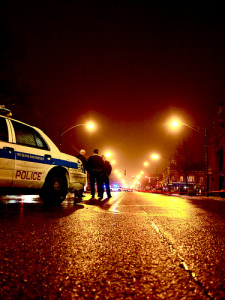The Illinois State Police announced the arrival of a new member to its K-9 unit recently, a dog trained in narcotics detection to aid in drug crimes investigations. I have discussed extensively on this blog the 4th Amendment right of all people to be free from unreasonable searches and seizures. But do those protections extend to police dogs?
Illinois Police Dogs and Search & Seizure
In 2005 the United States Supreme Court, in a decision that overruled the Illinois Supreme Court, ruled that the 4th Amendment prohibition against unreasonable search and seizures does not prohibit a trained police dog from being brought to the scene of a routine traffic stop to detect for illegal drugs.
In Illinois v. Caballes, the defendant was pulled over for a routine traffic stop. A K-9 unit responded to the officer’s radio regarding the stop. While the defendant was seated in the arresting officer’s vehicle, the dog was walked around the defendant’s vehicle, when it alerted its handler to the presence of drugs. A search of the defendant’s vehicle uncovered marijuana in the trunk.
The Illinois Supreme Court reversed the conviction, ruling that there had not been “specific and articulable facts” of any crime to justify the canine search. With the search deemed unconstitutional, the evidence had to be tossed out and there was no basis to support the conviction.
But the U.S. Supreme Court reinstated the conviction. Police dogs, the court said, are trained only to detect illegal contraband, which is not a legitimate privacy interest. If no drugs are present, then the privacy of the individual being sniff-searched has not been violated, because the dog cannot detect or convey any private information. Therefore, having a police dog sniff an area, even if there is no probable cause to assume the person being searched is in possession of drugs, does not constitute an unreasonable search and seizure. Probable cause to perform the subsequent search arises when the dog alerts to the presence of illegal contraband.
Because individuals do not have a privacy interest that can be violated by a sniff-search, can there ever be a case where a search by a K-9 unit is unreasonable?
In Caballes, the dog sniffed outside the defendant’s vehicle. Police would be unable to have the dog sniff inside the vehicle, without probable cause to believe that there was drugs inside. Likewise, a police dog could search outside a residence, but would be unable to search inside unless it alerted to drugs inside the home, or if the police had a search warrant for the home.
The search could also be unreasonable, and any evidence uncovered from it deemed inadmissible, if the dog’s handler did any of the following:
- Falsely claimed that the dog alerted to the presence of drugs and subsequently conducted a search;
- Encouraged the dog to alert to the presence of drugs, such as repeatedly pointing the dog to a location he had already searched and dismissed;
- Signaled the dog to alert in any manner, or;
- Searched a wider area than what the dog alerted to.
In any of these instances, the police officer’s act of forcing the dog to alert, or falsifying an alert, for the sole purpose of creating probable cause to support a search, would result in the search being deemed unreasonable. Continue reading
 Chicago Criminal Lawyer Blog
Chicago Criminal Lawyer Blog











